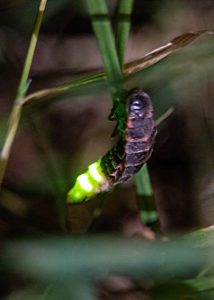Glow Worm Hunt 2022
On Friday evening Stephen, from Sustainable Silchester, led a glow worm hunt on the Common
At 9:30pm on a Friday evening in July, 35 local people met outside the Calleva Arms for a walk on the Common to hunt for glow worms. Stephen started by giving a short talk about glow worms. After 3-4 years as larvae, glow worms have a brief mating season for a couple of weeks in July, before dying. The female glow worms glow green in the night (like a small green LED) to indicate that they are ready to mate, and the much smaller male glow worms fly around to spot them. Each female has her own, quite large, patch so we were unlikely to see more than one green light at a time.
We set out at dusk, and it wasn’t long before three of the children spotted the first glow worm in a small gorse bush. As it go darker, we spotted more and more glow worms, and cries of “I’ve found one” rang round the Common as Erin rushed around trying to record locations for the record. In total we found 20 glow worms, although I have to say the children were much better at spotting them than I was.
Time flew by (like a male glow worm?), and I was surprised to find that it was past 11pm when we turned for home.
Why does Sustainable Silchester run an annual glow worm hunt?
 Glow worms are not rare in the UK and they are not an endangered species. As a result, they are never a priority in biodiversity or conservation action plans (for example, the current Hampshire Biodiversity Action makes no mention of glow worms). Silchester Common is a Site of Scientific Interest but it is not registered as such because of the presence of glow worms.
Glow worms are not rare in the UK and they are not an endangered species. As a result, they are never a priority in biodiversity or conservation action plans (for example, the current Hampshire Biodiversity Action makes no mention of glow worms). Silchester Common is a Site of Scientific Interest but it is not registered as such because of the presence of glow worms.
However, although glow worms are distributed throughout the UK they require a specific kind of habitat and that habitat is not present everywhere. We are lucky that we have some prime habitat for glow worms here in Silchester. That makes their presence in Silchester something unusual for Hampshire and something to celebrate. Although glow worms are not categorized as red list or endangered in the UK their presence has been declining steadily over recent years (for example, see the Gardiner Report, 2011: – Glowing, glowing, gone? The Plight of the Glow-worm).
There is no real data on exactly why this is happening but some of the principal causes which have been cited include habitat loss, global warming and increasing light pollution. More scientific study is needed to understand each of these effects in more detail. A further complicating factor in relation to glow worms is that they need very different habitats in their different life stages. In the larval stage (which lasts around 3 years and makes up 95% of their lifecycle) the larvae build up food reserves, feeding exclusively on snails and slugs. This requires a habitat which supports lots of gastropods such as in the taller, closed vegetation provided by the gorse and heather on the Common. In the adult stage (when the female glows) the habitat needs change. The female needs open areas of grassland in which to display clearly. This is provided by the grass margins and the rides on the Common.
So, it turns out that the Common, with its mixture of habitats is perfect for the glow worm. Who knows what will happen, however, if global warming continues to happen and the Common dries up so that it does not support a good population of snails or slugs anymore. Or what might happen if more street lighting and/or domestic lighting encroaches onto the darkness provided by the Common (there are lots of studies to show that the more light pollution increases the less successful males are at finding females).
So, for all these reasons, Sustainable Silchester takes the view that it is important to keep monitoring the presence of glow worms and have a readily available database of sightings built up over time so that this data can be used when making future decisions about the management of the Common and any development which encroaches upon it.
Thank you to all those people who have come along and helped with this project. We intend to continue in future years as the glow worm walk not only produces helpful data but it is great fun – people who have not seen a glow worm before are often genuinely delighted to see one for the first time.